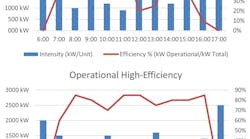The global industrial sector consumes about half of the world's total delivered energy, according to the U.S. Energy Information Association. The agency also estimates the industrial sector’s worldwide energy consumption will increase from 200 quadrillion Btu in 2010 to 307 quadrillion Btu in 2040.
Amid these high use rates and constantly fluctuating energy prices, it’s no surprise that manufacturers have made improved energy efficiency integral to their ongoing cost-reduction efforts. Common efforts include using utility rebates to carry out energy-improvement projects, upgrading to more efficient air compressors and chillers, updating HVAC systems; and working with utilities to generate payments for demand response.
By now, however, many organizations have exhausted the options available to them and are at a point where energy costs are simply considered a necessary expense that can’t be further controlled. Fortunately, industrial energy management is primed for a revolution thanks to two major forces that are set to convene: smart energy grids and smart, information-enabled industrial operations.
Countries around the world are working toward smarter, more connected energy grids to better measure, distribute and consume energy. In its publication The Smart Grid: An Introduction, the U.S. Department of Energy summarizes the smart grid and its primary benefits: “An automated, widely distributed energy delivery network, the Smart Grid will be characterized by a two-way flow of electricity and information and will be capable of monitoring everything from power plants to customer preferences to individual appliances. It incorporates into the grid the benefits of distributed computing and communications to deliver real-time information and enable the near-instantaneous balance of supply and demand at the device level.”
Smart grids have the potential to reduce the burden put on energy infrastructures, reduce blackout and brownout events, and enable end users to balance energy usage against peak energy rates. Cumulatively, this can help reduce costs for both utilities and end users.
The true value for manufacturers and industrial operators will be when the emerging benefits of the smart grid are combined with the benefits that many forward-thinking organizations already are realizing with information-enabled smart manufacturing.
Much has been discussed on how information-enabled operations can improve productivity, make processes more efficient, and reduce downtime. This is made possible by smart connected devices that can deliver more detailed insights into processes for better decision making, as well as the convergence of operations technology (OT) and information technology (IT) that enable seamless connectivity and greater information sharing across an organization.
But the benefits of information-enabled operations don’t stop there. They can also be extended beyond manufacturing processes to provide new, non-disruptive methods for accessing and monitoring energy-consumption data.
Some manufacturers already attempt to monitor their energy-consumption information through a top-down approach, in which consumption patterns are analyzed against production output. This can be effective for manufacturers with a limited product line, but it becomes an inadequate form of measurement as more complexity is introduced into operations, such as in the form of more product types and frequent line changeovers.
Conversely, a bottom-up approach that uses an energy-management system to meter energy at the point of production can produce detailed and more accurate energy data. On the down side, this approach can be complex in its execution and disruptive to production. It also can be a costly investment with ambiguous returns on investment.
Today, a new alternative is emerging that offers a more effective and more holistic approach to energy management. Connected smart devices now allow organizations to easily collect and share valuable machine information, including energy data that previously may have been locked inside machines and processes. Additionally, the growing adoption of networks such as EtherNet/IP – which is based on standard, unmodified Ethernet and Internet Protocol (IP) – helps ease the flow of this information to where it’s needed, rather than letting it languish in isolated data silos.
Now, energy-consumption data can be securely collected, tracked and shared just like production data. Equipped with this information, operators and plant managers can make machine and process adjustments to support smarter, more efficient energy usage.
Purchasing more-energy-efficient equipment is one thing. Understanding the savings they’re providing and where opportunities exist for additional cost-cutting is another. Information-enabled operations can help manufacturers optimize their energy consumption and reduce energy-related costs using two key metrics: energy consumption per production unit and operational energy performance.
Energy consumption per production unit can help manufacturers understand energy intensity (Intensity = kW / unit of production) and the extent to which energy contributes to the cost of specific assets, units, cells or processes. Operations can use this information to set baselines for measuring improvements and identify scenarios in which further investigation is needed.
Operational energy performance can help manufacturers understand energy efficiency (Efficiency = Productive Energy / Total Energy) by comparing the energy consumed during manufacturing against the total energy consumed during a set period of time. Only energy consumed during production should qualify as operational energy, while energy consumed during changeovers, quality holds and machine servicing should be considered non-production energy and be applied to the total energy per period.
Smarter energy management might seem like a future priority given that the smart grid is still taking shape and because only a fraction of manufacturers have connected their OT and IT systems into a single, unified network architecture that serves as the basis for smart manufacturing. However, manufacturers can take steps today to prepare their operations:
Austrian-born management expert Peter Drucker once said, “What gets measured, gets managed.” That’s especially true in the manufacturing world, and energy management represents the next great opportunity. By establishing seamless connectivity between OT and IT systems, using energy-aware connected technologies, and embracing the smart grid, manufacturers will be empowered with new information that will enable them to make smarter energy decisions and reduce costs across their operations.


